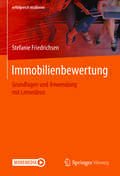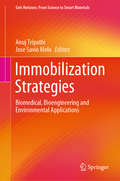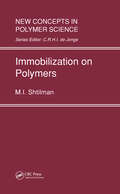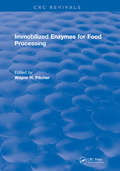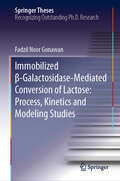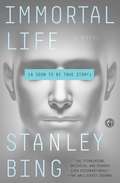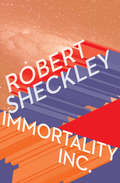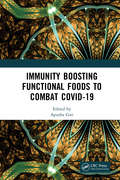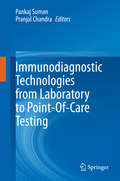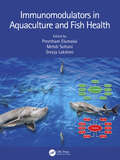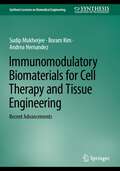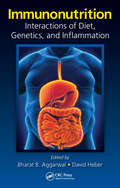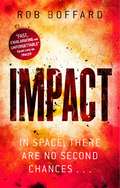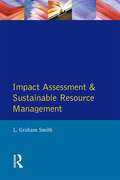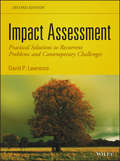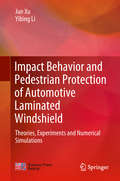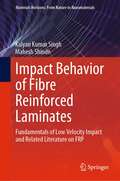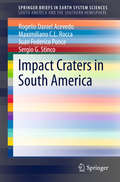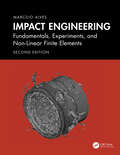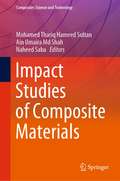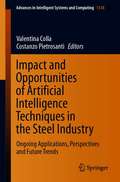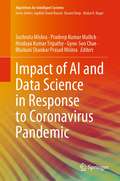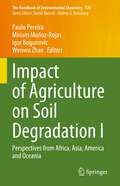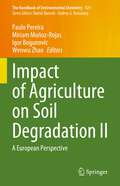- Table View
- List View
Immobilienbewertung: Grundlagen und Anwendung mit Lernvideos (erfolgreich studieren)
by Stefanie FriedrichsenDieses Lehrbuch führt in die Grundlagen der Immobilienbewertung ein. Studierende lernen sowohl die normierten Verfahren nach Immobilienwertermittlungsverordnung (ImmoWertV) als auch zwei sog. nicht normierte Verfahren zur Wertermittlung kennen.23 Kurzvideos zum Vorgehen bei den einzelnen Methoden der Wertermittlung und Beispielrechnungen veranschaulichen den Lehrstoff und unterstützen beim Lernen.Das Lehrbuch ist in der Springer Vieweg Reihe "erfolgreich studieren" erschienen.
Immobilization Strategies: Biomedical, Bioengineering and Environmental Applications (Gels Horizons: From Science to Smart Materials)
by Anuj Tripathi Jose Savio MeloThis book delves into the field of immobilizing biologically active and non-active molecules. It discusses the designing strategy of immobilization and the current state-of-the-art applications for advancing biomedical, agricultural, environmental and industrial practices. It focuses on aspects ranging from fundamental principles to current technological advances at multi-scale levels (macro, micro, and nano) which are suitable for cell, enzyme, and nano-catalyst based applications. Written by experts from across the globe, the contents deal with illustrated examples of molecular and cellular interactions with materials/scaffolds and discussions on factors that can affect the functionality and yield of the process. With its discussions on material science, design of delivery vehicles, separation science, additive manufacturing, agriculture and environmental science, this book will be a useful reference for researchers across multiple disciplines.
Immobilization on Polymers
by M.I. ShtilmanThis volume is devoted to the developments in the branch of polymer chemistry which deals with immobilized systems. These systems are widely used in fields connected with metabolism in humans, animals, plants and micro-organisms. The study of these artificial immobilized systems permits the understanding and design of the function and behaviour of natural substances in living organisms. The book contains the latest achievements in the field of synthesis of polymeric derivatives of different natural substances such as: proteins; peptides; amino acids; poly- and monosaccharides; nucleic acids; nucleosides; nucleotides; coenzymes; vitamines; alkaloids; antibiotics; steroids; hormones; and others. Special attention is given to natural and synthetic carriers and the influence of their chemical structure on the efficiency of systems obtained. This work should be of value and interest to researchers in the field of polymer chemistry, biotechnology and genetic engineering, medical chemistry, bio-organic chemistry and enzymology.
Immobilized Enzymes for Food Processing
by PitcherMuch has been written about immobilized enzymes during this period of time. So much, in fact, that it can become difficult even for those involved in developing new enzymatic food processing operations to bridge the gap between the field of immobilized enzymes and their specific requirements. It is the purpose of this book to assist those engaged in this difficult task. It is also a goal to bring to the researcher in enzyme immobilization an appreciation for the requirements of the food processing industry.
Immobilized β-Galactosidase-Mediated Conversion of Lactose: Process, Kinetics and Modeling Studies (Springer Theses)
by Fadzil Noor GonawanThis book describes the reaction rate profiles of the β-galactosidase-catalyzed conversion of lactose on the inner surface of a hollow fiber membrane, which is employed as an enzymatic reactor system. The reaction rate profiles were obtained by solving the mass transfer and kinetics of reaction in a 2-dimensional model of the system. The primary challenge of this research was to develop the kinetic model of the reaction to describe the kinetic behavior as the reaction occurred on the membrane surface. Despite the difficulties, the proposed model can reliably replicate the actual process, as validation procedures have confirmed. The reaction rates obtained analyze the performance of the immobilized enzyme on the membrane surface. Previously, an increase in performance of 'β-galactosidase-catalyzed conversion of lactose assisted by ultrafiltration was suggested due to inhibitor removal. However, as the analysis presented here shows, the concentration profile of the substrate on the membrane surface also affects the reaction performance.
Immortal Life: A Soon To Be True Story
by Stanley BingAn ancient mogul has bought the power to live forever, but the strong young body he plans to inhabit has other ideas. The battle for immortal life begins.Immortal Life. A fantasy. An impossible dream. For now, maybe. But as we speak the moguls of Big Tech are pouring their mountain of wealth into finding a cure for death. Don’t tell them they won’t succeed. None of these titans is richer than Arthur Vogel. This inventor, tech tycoon, and all-round monster has amassed trillions (with a T) and rules over a corporate empire stretching all the way to Mars. The newest—and most expensive—life extension technology has allowed him to live to 127 years, but time is running out. His last hope to escape the inevitable lies with Gene, a human being specifically created for the purpose of housing Arthur’s consciousness. The plan is to discard his used-up old carcass and come to a second life in a young, strong body with all appropriate working parts. But there’s a problem: Gene. He may be artificial, but he is a person. And he has other ideas. As Arthur sets off to achieve his goal of world domination, Gene hatches a risky plan of his own. The forces against him are very, very rich, extremely determined, and used to getting what they pay for. The battle between creator and creation is joined as the two minds wrestle for control of one body. This story is real. The tech is in development. The sponsors are the titans of industry well known to you. Eternal life may very soon be at the fingertips of those who can afford it. Mixing brisk action, humor, and wicked social commentary, Immortal Life imagines a day just around the corner. Welcome to a brave new world that is too familiar for comfort—and watch the struggle for humanity play out to the bitter end.
Immortality Inc.
by Robert SheckleyA man wakes up after a fatal car accident—in someone else&’s body—in this ahead-of-its-time Hugo Award–nominated classic. Thomas Blaine remembered the car accident that killed him—and then he woke up in the hospital. A nurse told him where he was. &“You&’d call it being in the future.&” A future where bodies are sold to the highest bidder as new homes for the minds of the rich, who are greedy for more life when their own bodies wear out or are damaged. Suddenly, keeping body and soul together has taken on a new, and very sinister, meaning. From the very beginning of his career, Robert Sheckley was recognized by fans, reviewers, and fellow authors as a master storyteller and the wittiest satirist working in the science fiction field. Open Road is proud to republish his acclaimed body of work, with nearly thirty volumes of full-length fiction and short story collections. Rediscover, or discover for the first time, a master of science fiction who, according to the New York Times, was &“a precursor to Douglas Adams.&”
Immunity Boosting Functional Foods to Combat COVID-19
by Apurba GiriIn this book, several functional foods or food ingredients, their mechanism of immune enhancing properties and use in food products have been discussed through seventeen chapters written by eminent authors. There are several medicinal plants which have significant role for immunity boosting such as Ashwagandha, Tulsi, Shatavari, Giloy, Aloe vera, Amla, Neem, licorice, garlic, ginger, turmeric, rosemary, black cumin, cinnamon, sage, thyme,fenugreek, peppermint, black pepper, clove etc. These have been discussed in detail.Note: T&F does not sell or distribute the hardback in India, Pakistan, Nepal, Bhutan, Bangladesh and Sri Lanka.
Immunity: How Elie Metchnikoff Changed the Course of Modern Medicine
by Luba VikhanskiAround Christmas of 1882, while peering through a microscope at starfish larvae in which he had inserted tiny thorns, Russian zoologist Elie Metchnikoff had a brilliant insight: what if the mobile cells he saw gathering around the thorns were the same as white blood cells that traveled to the site of an injury or infection in a human or other animal? Was this some form of cellular defense? Metchnikoff's theory of immunity, that phagocytes--white blood cells--formed the first line of defense against invading bacteria would eventually earn the scientist the unofficial moniker "Father of Natural Immunity" and a Nobel Prize. But first, he had to convince his colleagues, including the skeptical Robert Koch. Author Luba Vikhanski chronicles Metchnikoff's remarkable life, work, and discoveries in Immunity, the first modern biography of this hero of medicine. Metchnikoff was a towering figure in the scientific community of the early 20th century, a tireless humanitarian who worked to curb cholera, syphilis, and other diseases, and pioneered research into probiotics and gerontology. Though Metchnikoff is largely forgotten today, Vikhanski makes a compelling case that his work on natural immunity is finally receiving the attention it deserves.
Immunodiagnostic Technologies from Laboratory to Point-Of-Care Testing
by Pranjal Chandra Pankaj SumanThis book presents the timeline of immunodiagnostics evolution, including advancements in immunological/nucleic acid probes, assay design, labelling techniques, and devices for signal transduction and acquisition. In the past few years, enzyme and nanocatalyst-based immune assays have undergone numerous modifications to enhance their sensitivity and potential for automation. Further, to reduce production costs and the use of laboratory animals, engineering small antibodies and nucleic acid probes (aptamers) has become increasingly popular in the development of novel and powerful bioassays. In light of the notable advancements in immunodiagnostics, this book highlights the combined efforts of clinicians, biotechnologists, material scientists, nanotechnologists and basic scientists in a coherent and highly structured way. The book takes readers on the journey of immunodiagnostic technologies, from their introduction to the present.
Immunomodulators in Aquaculture and Fish Health
by Preetham Elumalai Sreeja Lakshmi Mehdi SoltaniThis reference book provides updated information about different immunomodulators for managing fish health and sustainable aquaculture. Immunomodulators are dietary additives that enhance innate defense mechanisms and increase resistance against specific pathogens and diseases. The book covers the different types of immunostimulants, their modes of action, and their efficacies. It also reviews safety concerns, ethical regulations, limitations, and outreach to farmers. It discusses the application of herbal immunomodulators, antioxidants, pre- and pro-biotics, in disease management. Features:• Reviews the pressing topic of reduction of antibiotic use in aquaculture • Discusses herbal immunomodulators, nutrients, antioxidants and pre- and pro-biotics • Covers the topic of progressive immunomodulation using nanotechnology • Discusses fish health management in the ever-growing aquaculture industry • Includes natural and synthetic immunomodulators The book is meant for researchers and industry experts in aquaculture, fisheries science, and veterinary medicine.
Immunomodulatory Biomaterials for Cell Therapy and Tissue Engineering: Recent Advancements (Synthesis Lectures on Biomedical Engineering)
by Sudip Mukherjee Boram Kim Andrea HernandezThis book presents the recent developments in immunomodulatory biomaterials for cell-based therapies in various diseases, including diabetes, cancer, cardiovascular disease, and bone regeneration. The authors first cover the fundamentals of conventional immunology and immunomodulation, before focusing on the history, advantages, and challenges of cell therapies. Biological cell therapy has gained immense attention for various diseases due to unique advantages it has over chemical drugs regarding cost, ease of production, toxicity, and therapeutic efficacy. However, these cell-based therapies need an inert delivery system that can locally deliver cells and minimally elicit foreign body response. The book discusses the foreign body response to the immunomodulatory biomaterials as well as the current and future strategies for potential mitigation of considerable immune responses toward immunomodulatory biomaterials and devices.
Immunonutrition: Interactions of Diet, Genetics, and Inflammation
by David Heber Bharat B. AggarwalThe interaction of immune function and nutrition underlies the low-grade chronic inflammation involved in the etiology of many common obesity-associated and age-related chronic disease conditions. This close interaction is the genesis of the term immunonutrition, which represents a new interdisciplinary field of nutritional and medical research. Im
Impact (Outer Earth #3)
by Rob BoffardFollowing Tracer and Zero-G comes Impact, the explosive conclusion to the Outer Earth trilogy - a heart-pounding thriller set in space where the hero moves like lightning and the consequences for failure are deadly. A signal has been picked up from Earth. The planet was supposed to be uninhabitable. But it seems there are survivors down there - with supplies, shelter and running water. Perhaps there could be a future for humanity on Earth after all. Riley Hale will find out soon enough. She's stuck on a spaceship with the group of terrorists that is planning to brave the planet's atmosphere and crash-land on the surface. But when the re-entry goes wrong, Riley ends up hundreds of miles from her companions Prakesh and Carver, alone in a barren wilderness. She'll have to use everything she knows to survive. And all of them are about to find out that nothing on Earth is what it seems . . .
Impact Assessment and Sustainable Resource Management (Themes In Resource Management)
by L Graham SmithFirmly places impact assessment in the broader context of environmental planning, developing a much-needed integrative approach. The topics covered include: decision making and dispute resolution; the role of environmental law; public policy, administration and publication participation; the nature of planning; impact assessment methodology; the application of impact assessment to frontier developments; linear facilities and waste mana
Impact Assessment: Practical Solutions to Recurrent Problems and Contemporary Challenges
by David P. LawrenceOffers solutions and best practices to respond to recurrent problems and contemporary challenges in the field Since the publication of the first edition of Environmental Impact Assessment in 2003, both the practice and theory of impact assessment have changed substantially. Not only has the field been subject to a great deal of new regulations and guidelines, it has also evolved tremendously, with a greater emphasis on strategic environmental, sustainability, and human health impact assessments. Moreover, there is a greater call for impact assessments from a global perspective. This Second Edition, now titled Impact Assessment to reflect its broader scope and the breadth of these many changes, offers students and practitioners a current guide to today's impact assessment practice. Impact Assessment begins with an introduction and then a chapter reviewing conventional approaches to the field. Next, the book is organized around recurrent problems and contemporary challenges in impact assessment process design and management, enabling readers to quickly find the material they need to solve tough problems, including: How to make impact assessments more influential, rigorous, rational, substantive, practical, democratic, collaborative, ethical, and adaptive How each problem and challenge-reducing process would operate at the regulatory and applied levels How each problem can be approached for different impact assessment types—sustainability assessment, strategic environmental assessment, project-level EIA, social impact assessment, ecological impact assessment, and health impact assessment How to link and combine impact assessment processes to operate in situations with multiple overlapping problems, challenges, and impact assessment types How to connect and combine impact assessment processes Each chapter first addresses the topic with current theory and then demonstrates how that theory is applied, presenting requirements, guidelines, and best practices. Summaries at the end of each chapter provide a handy tool for structuring the design and evaluation of impact assessment processes and documents. Readers will find analyses and new case studies that address such issues as multi-jurisdictional impact assessment, climate change, cumulative effects assessment, follow-up, capacity building, interpreting significance, and the siting of major industrial and waste facilities. Reflecting current theory and standards of practice, Impact Assessment is appropriate for both students and practitioners in the field, enabling them to confidently respond to a myriad of new challenges in the field.
Impact Behavior and Pedestrian Protection of Automotive Laminated Windshield: Theories, Experiments And Numerical Simulations
by Jun Xu Yibing LiThis book addresses one of the most important components for pedestrian safety in vehicles – laminated windshields. It includes detailed real-world material characterization results for laminated glass and testing methodologies, constitutive models, and step-by-step numerical simulation modeling and simulation methods. As such, the book provides readers a thorough understanding of the mechanical behaviors of laminated glass and windshields. It also presents fundamental test data, analysis methodologies and essential insights into laminated glass safety design and mechanical behavior prediction. The book addresses the needs of researchers, engineers and postgraduate students in the fields of automotive engineering, mechanical engineering and related areas.
Impact Behavior of Fibre Reinforced Laminates: Fundamentals of Low Velocity Impact and Related Literature on FRP (Materials Horizons: From Nature to Nanomaterials)
by Kalyan Kumar Singh Mahesh Shinde^ This highly informative and carefully presented volume highlights the impact behavior of fibre reinforced polymer composites. It begins with a preliminary focus on FRP materials, fabrication processes, micro- and macro- mechanics to calculate FRP laminates properties, damage nodes associated with FRP composites under different loadings. It provides a simple and unified approach to cover aspects of FRP composites behavior with low velocity impact loading. This book offers a valuable guide for those who wish to develop deeper insights into weaving architectures, stacking sequences, fabrication processes, general damage modes associated with FRP composites. It is a useful volume for students, academia and industry alike.^
Impact Craters in South America
by Rogelio Daniel Acevedo Maximiliano C. L. Rocca Juan Federico Ponce Sergio G. StincoA complete and updated catalogue of impact craters and structures in South America from 2014 is presented here. Approximately eighty proven, suspected and disproven structures have been identified by several sources in this continent. All the impact sites of this large continent have been exhaustively reviewed: the proved ones, the possible ones and some very doubtful. Many sites remain without a clear geological "in situ" confirmation and some of them could be even rejected. Argentina and Brazil are leading the list containing almost everything detected. In Bolivia, Chile, Colombia, Guyana, Paraguay, Perú, Uruguay and Venezuela only a few were observed. Only Ecuador is waiting for new discoveries. So far, the largest well stated impact site is still the Araguainha structure in Brazil with its 40 kilometers in diameter. However, two possible impact structures are larger than Araguainha: Malvinas, (with 250 kilometers in diameter) and Vichada in Colombia, (50 kilometers). This study also reports the existence of some Tertiary-Quaternary glassy impactite layers: the "escorias" and "tierras cocidas" of the pampas in Argentina.
Impact Engineering: Fundamentals, Experiments, Nonlinear Finite Elements
by Marcílio AlvesThis second edition of Impact Engineering covers the dynamic analysis of structures undergoing small to large displacements, linear and nonlinear elastic material behavior to viscoplasticity, and the range of features of structural impact analysis.Individuals, as well as various governing bodies are concerned about protection against natural hazards, crash-type accidents, and terrorism- commonly referred to as "impact"- implying a rapid loading process. The book discusses the physics involved in such impact situations and incorporates analytical considerations as well as techniques to obtain and interpret experimental data and relevant numerical techniques. It also includes a chapter on scaling which is a relevant aspect when studying impact on large structures.This book will be useful for advanced students and professionals in civil and mechanical engineering as well as for students and researchers in applied physics and other relevant disciplines.
Impact Studies of Composite Materials (Composites Science and Technology)
by Naheed Saba Mohamed Thariq Hameed Sultan Ain Umaira Md ShahThis book discusses the impact of different range of velocities (low, high, ballistic and hyper-velocity impact) on composites. Presented through experimental and numerical analysis, the book goes beyond impact event analysis and also covers the after-impact phenomena, including flexural and compression and damage analysis through destructive and non-destructive evaluations. The analyses presented from either experimental or numerical simulations are composed of micro and macrographs images, illustrations, tables and figures with inclusive discussions and supportive evidences from recent studies on composites. This book also highlights the potential applications of composites through the lens of their impact properties, in different industries such as automotive and defence applications. Generally, this book benefits wider range of readers including the industrial practitioners, researchers, lecturer and students, who are working in the fields related to impact and damage analysis, including the structural health monitoring of composites, either experimentally or numerically.
Impact and Opportunities of Artificial Intelligence Techniques in the Steel Industry: Ongoing Applications, Perspectives and Future Trends (Advances in Intelligent Systems and Computing #1338)
by Valentina Colla Costanzo PietrosantiThis book collects perceptions and needs expectations and experiences concerning the application of Artificial Intelligence (AI) and Machine Learning in the steel sector. It contains a selection of themes discussed within the Workshop entitled “Impact and Opportunities of Artificial Intelligence in the Steel Industry” organized by the European Steel Technology Platform as an online event from October 15 until November 5, 2020. The event aimed at analyzing the diffusion of AI technologies in steelworks and at providing indications for future research, development and innovation actions addressing the sector demands. The chapters treat general analyses on transversal themes and applications for process optimization, product quality enhancement, yield increase, optimal exploitation of resources and smart data handling. The book is devoted to researchers and technicians in the steel or AI fields as well as for managers and policymakers exploring the opportunities provided by AI in industry.
Impact of AI and Data Science in Response to Coronavirus Pandemic (Algorithms for Intelligent Systems)
by Bhabani Shankar Prasad Mishra Pradeep Kumar Mallick Gyoo-Soo Chae Hrudaya Kumar Tripathy Sushruta MishraThe book presents advanced AI based technologies in dealing with COVID-19 outbreak and provides an in-depth analysis of variety of COVID-19 datasets throughout globe. It discusses recent artificial intelligence based algorithms and models for data analysis of COVID-19 symptoms and its possible remedies. It provides a unique opportunity to present the work on state-of-the-art of modern artificial intelligence tools and technologies to track and forecast COVID-19 cases. It indicates insights and viewpoints from scholars regarding risk and resilience analytics for policy making and operations of large-scale systems on this epidemic. A snapshot of the latest architectures, frameworks in machine learning and data science are also highlighted to gather and aggregate data records related to COVID-19 and to diagnose the virus. It delivers significant research outcomes and inspiring new real-world applications with respect to feasible AI based solutions in COVID-19 outbreak. In addition, it discusses strong preventive measures to control such pandemic.
Impact of Agriculture on Soil Degradation I: Perspectives from Africa, Asia, America and Oceania (The Handbook of Environmental Chemistry #120)
by Paulo Pereira Miriam Muñoz-Rojas Igor Bogunovic Wenwu ZhaoThis is the first of two volumes that together provide a global overview of the impact of agriculture on soil degradation, tracing the most critical drivers like the use and abuse of agrochemicals, mechanization, overgrazing, irrigation, slash and burn agriculture, and the use of plastics. This book covers the main effects of agriculture practices on soil degradation in several countries from Africa, America, Asia, and Oceania, and it elucidates the impact of chemical agents on soil quality, namely, the use of fertilizers, herbicides, pesticides, soil acidification and microplastics pollution. In these continents, a large number of the population depend on agriculture, which sets an enormous pressure on the ecosystems. Divided into 13 chapters, the book offers authoritative contributions about the fundamental soil degradation problems in countries such as Argentina, Australia, Peru and Bolivia, Brazil, Chile, China, Colombia, India, Israel, Kenya, Mexico, South Africa, the United States of America. As soil degradation issues are often linked with biodiversity loss and poverty, readers will also find in this book an important discussion of the different social, economic, political, and environmental aspects contributing to soil quality and sustainable management. Given the breadth and depth of its coverage, the book offers an invaluable source of information for researchers, students, environmental managers and policymakers alike.
Impact of Agriculture on Soil Degradation II: A European Perspective (The Handbook of Environmental Chemistry #121)
by Paulo Pereira Miriam Muñoz-Rojas Igor Bogunovic Wenwu ZhaoThis is the second of two volumes that together provide a global overview of the impact of agriculture on soil degradation, tracing the most critical drivers like the use and abuse of agrochemicals, mechanization, overgrazing, irrigation, slash and burn agriculture, and the use of plastics.Soil degradation caused by agriculture practices is a complex issue which depends on the interaction of social, economic, political, and environmental aspects. In this book, expert contributors elucidate the extension of the effects of agriculture on soil degradation in Europe, a continent with different cultures and political backgrounds that affect agricultural practices. Readers will also find in this book authoritative solutions to minimize the effects of agriculture intensification and land-use in this continent. Divided into 12 chapters, the book offers a European perspective on soil quality and sustainable management, including case studies about the impact of chemical agents like fertilizers, herbicides, pesticides, and soil acidification and microplastics pollution in agriculture practices from countries such as Croatia, Czech Republic, Estonia, Latvia and Lithuania, Germany, Portugal and Greece, Hungary, Iceland, Italy, Slovenia, Spain, Sweden, and Ukraine. Given the breadth and depth of its coverage, the book offers an invaluable source of information for researchers, students and environmental managers alike.
